Locking a screen door is an essential practice to ensure the security and safety of your home. Whether you’re stepping out for a short period or retiring for the night, knowing how to properly secure your screen door can provide peace of mind.
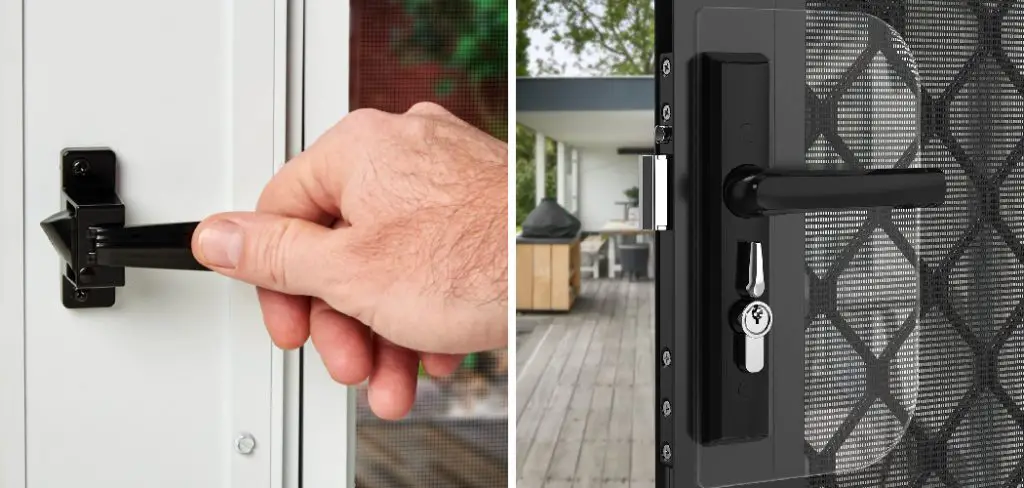
In this guide on how to lock screen door, we will walk you through the steps to effectively lock your screen door, helping you protect your living space from unwanted entry and enhancing your overall home security.
Why is Locking the Screen Door Important?
Locking your screen door is crucial for several reasons. First and foremost, it acts as a deterrent to potential intruders, making it more difficult for unauthorized individuals to access your home. This added layer of security not only protects your possessions but also ensures the safety of your family members.
Additionally, a locked screen door prevents wildlife and stray animals from entering your home, reducing the risk of damage or unexpected encounters. It can also help keep young children and pets inside, providing an extra barrier of protection. Ultimately, consistently locking your screen door is a simple yet effective way to enhance the overall security and safety of your living environment.
You may also want to consider locking your screen door for energy efficiency purposes. A properly secured screen door can help keep the cool or warm air inside, reducing your energy consumption and ultimately saving you money on utility bills.
It’s important to note that not all screen doors come with built-in locks, so it’s essential to check if your screen door has a locking mechanism or if you need to add one.
Necessary Materials
Before we dive into the steps of locking your screen door, let’s first make sure you have all the necessary materials. Depending on the type of screen door and its existing features, some or all of these items may be required:
Key (if Your Screen Door Has a Built-in Lock):
If your screen door has a built-in lock, you will need a key to operate it. Make sure you have the correct key on hand and that it is easily accessible in case of emergency.
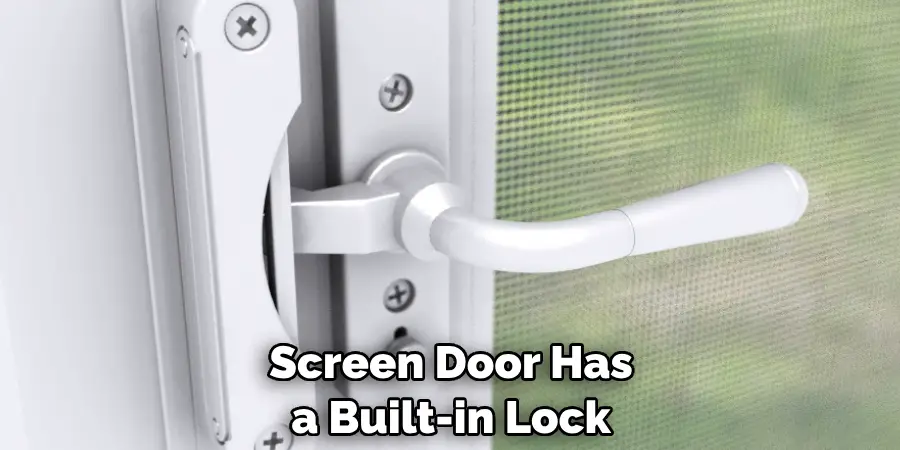
Latch or Deadbolt:
If your screen door does not have a built-in lock, you will need to install either a latch or a deadbolt. These can be purchased from most hardware stores and come with installation instructions.
Screws and Screwdriver:
You may need screws and a screwdriver if installing a new lock on your screen door. Be sure to check the specifications of the lock to determine the appropriate size for the screws.
8 Steps on How to Lock Screen Door
Step 1: Close Your Screen Door Securely
Ensure your screen door is completely closed before attempting to lock it. Check that the door fits snugly in the frame and that there are no gaps or misalignments. A properly closed screen door will make the locking process more effective and secure. Listen for a click or latch engagement sound, indicating that the door is fully shut and ready for the next step. It’s also a good idea to test the door by gently pushing or pulling it to make sure it is secure.
Step 2: Check for Any Obstructions
Before you lock your screen door, inspect the area around it for any obstructions that might impede the locking process. Look for items such as dirt, debris, or foreign objects lodged in the door track or frame. Remove any such obstructions carefully to ensure the door closes and locks smoothly. Additionally, check that the locking mechanism itself is free of dirt and grime, which could affect its functionality. Ensuring the path is clear and clean will help the lock operate more efficiently and maintain the security of your screen door.
Step 3: Determine the Type of Lock on Your Screen Door
Identify the type of locking mechanism your screen door uses. Common types of locks include built-in locks, latch locks, deadbolts, and hook-and-eye latches. If your screen door has a built-in lock, locate the keyhole and ensure you have the appropriate key. For latch locks or deadbolts, look for the lever or thumb turn used to engage the lock.
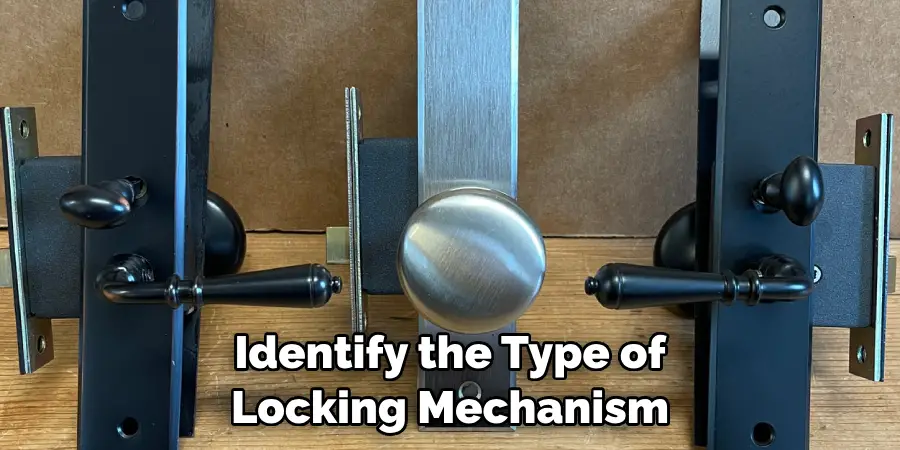
Hook-and-eye latches typically require you to align and insert a small hook into an eyelet to secure the door. Knowing the type of lock will help you understand the locking process and may assist in troubleshooting if the lock does not engage properly. If you are unsure, consult any available documentation or inspect the door’s mechanism closely to determine the type.
Step 4: Check the Lock’s Condition
Before locking your screen door, it’s important to check the condition of the lock to ensure it is functioning properly. Examine the lock for any signs of wear and tear, rust, or damage that could impede its operation. Test the lock mechanism to see if it operates smoothly; try turning the key, lever, or thumb turn to ensure it engages and disengages without resistance.
If you encounter any difficulties, consider lubricating the lock with a graphite-based lubricant or silicone spray to improve its functionality. In some cases, you might need to replace a damaged or worn lock. Addressing any issues with the lock’s condition beforehand will ensure it operates effectively and enhances the security of your screen door.
Step 5: Secure the Lock
Once you have verified that your screen door’s lock is in good working condition, it’s time to secure it. If your door has a built-in lock, insert the key into the keyhole and turn it until you hear a click, indicating that the lock has engaged. For a latch lock, slide the latch into place firmly to ensure it is secured. If you’re using a deadbolt, rotate the thumb turn or key to extend the bolt fully into the door frame. For a hook-and-eye latch, align the hook with the eyelet and insert it to lock the door.
Double-check that the lock is fully engaged by gently pulling or pushing the door to confirm it is immovable. Properly securing the lock will ensure that your screen door remains protected against unauthorized entry, contributing to your home’s overall security.
Step 6: Test the Lock
After securing the lock, it is essential to test it to ensure that it is functioning correctly. Begin by trying to open the screen door from both the inside and outside. Apply gentle pressure to confirm that the lock is holding the door securely in place. If the door remains immovable, the lock is operating properly.
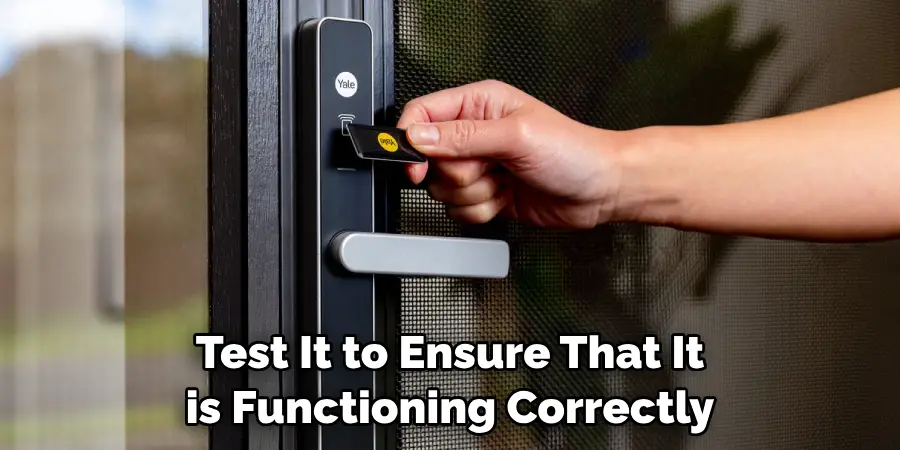
If the door opens or feels loose, reassess the lock mechanism and make any necessary adjustments. Additionally, it’s a good idea to repeat the locking and unlocking process a few times to verify consistency and reliability. Thoroughly testing the lock will give you peace of mind, knowing that your screen door is effectively secured.
Step 7: Make a Habit of Locking Your Screen Door
It’s crucial to make locking your screen door a habit, especially when leaving your home or going to bed. It only takes a few seconds to secure the lock, but it can significantly enhance your home’s security and protect against potential intruders. Encourage everyone in your household to follow this practice consistently to maintain the integrity of your door’s security features.
Additionally, regularly checking and maintaining the lock will help keep it in good working condition for long-term use. It’s better to be safe than sorry, so make locking your screen door a top priority.
Step 8: Consider Additional Security Measures
While a secure lock is essential, it’s also wise to consider additional security enhancements for your screen door. Installing a secondary lock, such as a sliding bolt or chain lock, can provide an extra layer of protection and deter potential intruders. Security bars or grilles can be fitted over the screen door to prevent forced entry while still allowing ventilation.
Another option is to use security film on the glass, making it more difficult for someone to break through. Lastly, installing an alarm system or motion sensor near your screen door can alert you to any suspicious activity. By adopting these additional measures, you can significantly enhance the overall security of your screen door and protect your home more effectively.
Following these steps on how to lock screen door and taking additional security measures will help ensure that your screen door remains a durable and safe barrier for your home. By regularly checking and maintaining the lock, you can feel confident in the protection it provides.
Remember to always lock your screen door when leaving or going to bed, and consider investing in additional security measures for added peace of mind. With a secure screen door, you can enjoy the fresh air and sunlight while keeping your home safe and secure.

Regular Maintenance and Troubleshooting
Regular Maintenance
Regular maintenance is essential to ensure your screen door lock operates smoothly and provides reliable security. Start by cleaning the lock and surrounding areas periodically to remove dirt, dust, and debris that can impede the lock’s function. Use a mild detergent and a soft cloth to wipe down the lock, being careful not to introduce excessive moisture, which can lead to rust.
Lubricating the lock mechanism is also crucial. Apply a graphite-based lubricant or silicone spray to the keyhole, latch, and any moving parts to help reduce friction and prevent wear.
Avoid using oil-based lubricants, as they can attract more dirt and grime. Additionally, check the alignment of the door and lock; if the door sags or the lock does not align properly with the frame, it may not engage correctly. Tighten any loose screws on the hinges or the lock plate to maintain proper alignment.
Troubleshooting Common Issues
Despite regular maintenance, you may encounter some common issues with your screen door lock. Here are a few troubleshooting tips:
Key Won’t Turn:
If the key does not turn in the lock, it could be due to dirt build-up or a worn key. Try cleaning the key and the keyhole, and lubricate the lock. If the issue persists, consider getting a new key cut or replacing the lock.
Lock Sticks or Is Hard to Engage:
A lock that is difficult to engage may need lubrication. Apply a suitable lubricant to the locking mechanism. If lubrication does not solve the problem, inspect the lock for signs of damage or wear that may require replacement.
Misalignment:
If the lock does not align properly with the latch plate, the door may not be closing correctly. Check the door’s alignment and adjust the hinges or latch plate as needed. This can often be corrected by tightening screws or repositioning the latch plate.
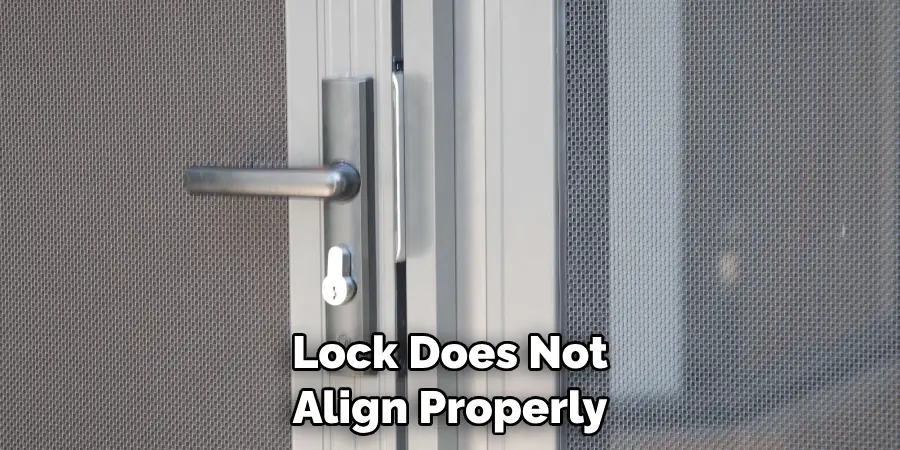
Rust or Corrosion:
If the lock shows signs of rust or corrosion, it may impede its operation. Clean off any rust using a rust remover or fine sandpaper and apply a rust-inhibiting product to help prevent future corrosion.
By following these maintenance tips and troubleshooting common issues, you can keep your screen door lock in top working condition and maintain your home’s security. Remember to regularly inspect and test the lock and address any problems promptly to ensure reliable protection for your home.
Real-Life Examples and Case Studies
Case Study 1: The Smith Family’s Enhanced Security
The Smith Family, residing in a suburban neighborhood, experienced two attempted break-ins within six months. Initially, they relied solely on the standard lock that came with their screen door.
Following the incidents, they decided to implement additional security measures. The family installed a secondary sliding bolt, added security bars over the screen door, and applied security film to the glass. Additionally, they set up a motion sensor that triggers an alarm if any suspicious activity is detected near the door. Since making these enhancements, the Smith Family has experienced no further break-in attempts, and they feel significantly more secure in their home.
Case Study 2: Maintaining Security in a Rental Property
John, a landlord who owns multiple rental properties, recognized the importance of maintaining secure screen doors for his tenants. In one of his properties, a tenant reported that the screen door lock was becoming difficult to operate and often stuck. John responded promptly by inspecting the lock and found that dirt and rust had accumulated over time.
He cleaned the lock thoroughly, applied a graphite-based lubricant, and ensured the door was properly aligned. By implementing a regular maintenance schedule, John has successfully prevented further issues and kept his tenants safe and satisfied.
Case Study 3: Deterred Intruders with a Simple Alarm Addition
In an urban apartment complex, Jane and her roommates faced safety concerns after hearing about a series of break-ins in nearby units. They decided to take proactive steps to enhance their security. While their screen door was equipped with a robust lock, they added a simple, affordable door alarm that emits a high-pitched sound when the door is tampered with.
One night, the alarm was triggered, scaring off an intruder who was attempting to break in. The alarm’s effectiveness demonstrated that even minor security enhancements could make a significant difference in deterring potential threats.

These real-life examples highlight the importance of not only securing your screen door with a sturdy lock but also considering additional measures and regular maintenance. Whether it’s preventing attempted break-ins, maintaining rental properties, or using alarms to deter intruders, these steps collectively contribute to a more secure and safer living environment.
Frequently Asked Questions
Q: How Often Should I Check the Condition of My Screen Door’s Lock?
A: It is recommended to check the condition of your screen door’s lock at least once a month. However, if you notice any signs of wear and tear or encounter difficulties when locking or unlocking the door, you should inspect the lock immediately and address any issues as needed.
Q: Can I Use WD-40 to Lubricate My Screen Door’s Lock?
A: While WD-40 is a lubricant, it is not recommended for use on locks as it can attract dust and debris, leading to potential malfunctions. Instead, opt for a graphite-based lubricant or silicone spray specifically designed for locks.
Q: What Should I Do if My Screen Door’s Lock Malfunctions?
A: If your screen door’s lock malfunctions, try troubleshooting by first checking the condition of the lock and ensuring it is properly lubricated. If the issue persists, consider consulting a professional locksmith or replacing the lock altogether. It is crucial to address any malfunctions promptly to maintain the security of your screen door and home.
Q: What Are Some Additional Security Measures I Can Take for My Screen Door?
A: There are various additional security measures you can consider for your screen door, such as installing a secondary lock, adding security bars or grilles, using security film on the glass, or installing an alarm system or motion sensor. These enhancements can provide an extra layer of protection and deter potential intruders from attempting to break in through your screen door.
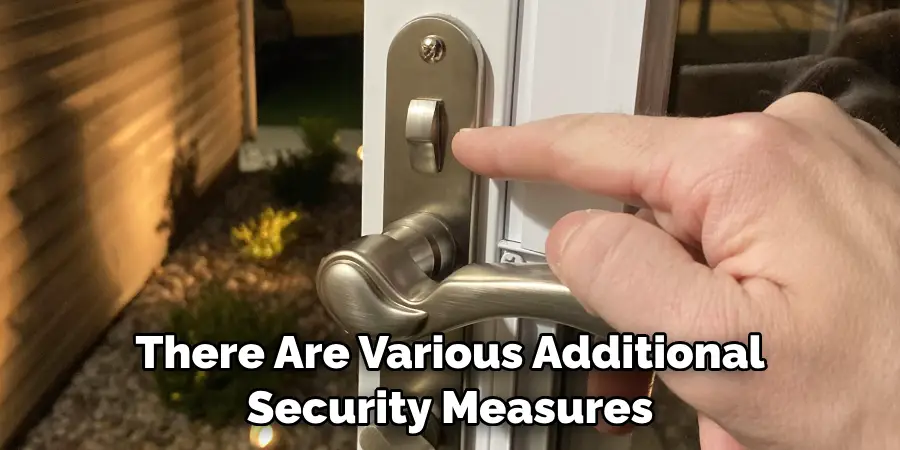
Conclusion
Securing your screen door is a simple yet crucial step in safeguarding your home. By following the outlined steps on how to lock screen door—understanding your lock type, checking its condition, properly securing it, and testing its functionality—you can ensure that your screen door provides the protection you need. Developing the habit of locking your screen door regularly, especially when leaving home or retiring for the night, significantly boosts your home’s security.
Additionally, considering extra security measures like secondary locks, security bars, or alarm systems can offer further peace of mind. A secure screen door not only enhances your home’s security but also allows you to enjoy fresh air and natural light without compromising safety. Remember, a well-maintained and properly secured screen door is an essential component of a secure and comfortable home environment.
